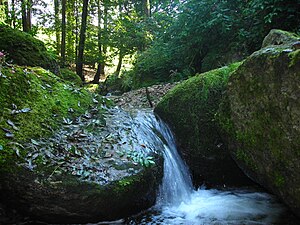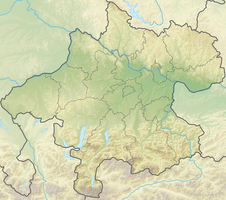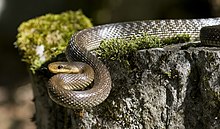Pesenbachtal
|
Pesenbachtal
|
||
|
Pesenbachtal nature reserve |
||
| location | Urfahr area district ; Rohrbach district ; Municipality Feldkirchen an der Donau , community Herzogsdorf and community St. Martin im Mühlkreis | |
| surface | 250 ha | |
| Identifier | n022 | |
| Geographical location | 48 ° 22 ' N , 14 ° 4' E | |
|
|
||
| Setup date | 1963 | |
| administration | Province of Upper Austria | |
| particularities | 1. Nature reserve in the Mühlviertel | |
The Pesenbachtal is a notch valley in the Mühlviertel in Upper Austria on the southern edge of the Bohemian Massif . In 1963 it was declared a nature reserve as the first area in the Mühlviertel ; it is also the largest in the region. The eponymous Pesenbach arises in St. Johann am Wimberg and flows into the Danube shortly before Ottensheim .
The Pesenbachtal is known for its 250 hectare , natural white water landscape north of the Danube, through which the stream runs down into the valley. Many rare animals and plants are at home there. The natural monuments sculpted by water and wind erosion have become landmarks.
The majority of the valley area was created by the creek cutting into the hard rock ( Weinsberg granite and coarse-grain gneiss). The southern and central parts of the valley are surrounded on both sides by steep and wooded slopes. The stream is very narrow and the distance to the bank is only a few meters wide.
The Oberwallsee castle ruins above the Pesenbach valley have been uninhabited since the 1980s and are left to decay. The Pesenbachtal is mentioned in numerous legends and myths . In the Kneipp culture institute of the Sisters of Mary from Carmel, the water from the Bruno spring is served to guests during meals.
Pesenbach
The Pesenbach arises from two source streams in St. Johann am Wimberg at 700 m above sea level. A. and has a total length of 34 kilometers. The catchment area covers 103.5 km², more than half of which are higher than 440 m above sea level. A. The gradient is 13 ‰ on average, but varies a lot. The course of the river is divided into four sections:
| section |
Length [km] |
Gradient [‰] |
Characteristic |
|---|---|---|---|
| Upper course | 6th | 29 | steep |
| Middle section | 14th | 8.5 | flat |
| Breakthrough route | 2.5 | 50 | very steep |
| Lower course | 11.5 | 2 | very flat |
The water donation with mean water flow is 10.3 l / s · km², with low water flow it falls to 1 l / s · km².
(Nature) monuments
In the Pesenbachtal you can find numerous monuments, some of which were created naturally. The vernacular has given them special names.
Forest worship
Forest worship is the name of a cross in the Pesenbachtal near the Tiefenbach, which rises in Gerling (Herzogsdorf municipality) and flows into the Pesenbach. The monument surrounded by the forest landscape is a place of reflection.
Goaßkirche
The so-called Goaßkirche was formerly called Klausbachdachl and is a stone slope made of granite blocks that were formed underground by erosion processes. During storms, the trees collapse over the stone blocks and form a roof .
Blue alley
Over 300 million years ago, in the Permian Age , an earthquake split the bedrock of the Pesenbach and magma penetrated into the crevice. As it cooled rapidly and solidified, a small crystalline, compared to the rock environment less erosion resistant originated via fill out porphyrite . That is why the Pesenbach later cut into the rock in a channel only one meter wide.
Candle stone
The twelve meter high candle stone high above the brook is the landmark of the Pesenbach valley. The 40-meter-high granite column, which has been awarded a natural monument , consists of two boulder towers. The natural formation was formed by wind grinding , geologists speak of wool sack weathering and the associated erosion phase. The upper block in particular resembles a stuffed wool sack, the second rests on a sloping joint.
Green pond
The green pond is the largest pond in the Pesenbach. With a small waterfall, the water flows over the rocks into the pond and provides a habitat for animals and plants. A particularly large number of grove chickweed grow near the shore. Larger slabs of porphyrite are located between the rocks.
Stone roof
The Steinerne Dachl is a roof-shaped rock overhang in the Pesenbachtal.
Devil vats
The devil's tubs are large, round basins in the course of a stream, in which, according to legend, the devil is supposed to live. Other myths claim that the vats were used as bathing spots for the devil. The water of the Pesenbach is strongly stirred up at these points.
Brunoquelle
The Pesenbachtal is characterized by gorges and ponds. The Brunoquelle has been known since 1364. The slightly radioactive healing water is used in the Bad Mühllacken Kneipp cure facility operated by the Sisters of Mary from Carmel , which is only about 700 meters away from the source. The water is fetched from the spring every day and mostly served with meals. It contains many trace elements, in particular it is very rich in iron and manganese. According to legend, water saved the life of the sick squire Bruno as early as the 14th century.
fauna and Flora
fauna
In Pesenbachtal numerous bird species: wren ( Troglodytes troglodytes ), dipper ( Cinclus cinclus ), warblers such as willow warbler ( Phylloscopus trochilus ) and Chiffchaff ( Phylloscopus collybita ), and Goldcrest ( Regulus regulus ) and Treecreeper ( Certhia familiaris ), as well as Robin ( Erithacus rubecula ) and great spotted woodpecker ( Dendrocopos major )
Since the common buzzard ( Buteo buteo ) prefers small forest areas, it is represented in the valley.
The Pesenbach Valley offers a safe habitat for the green lizard ( Lacerta viridis ) but also for the rare Aesculapian snake ( Zamenis longissimus ). It is possible that the Aesculapian snake was brought to Austria by the Romans around the 3rd century BC.
In the Pesenbach valley you can also find numerous butterflies : the swallowtail , the great blue butterfly ( Apatura iris ), the admiral ( Vanessa atalanta ) and various forms of the mother- of- pearl butterfly ( Argynnis aglaja ).
Among the mammals, otters ( Lutra lutra ), badgers ( Meles meles ), ermines ( Mustela erminea ) and pine marten ( Martes martes ) are worth mentioning.
The brown trout ( Salmo trutta ) offers the high water quality an ideal habitat, it feeds on insects and smaller fish.
flora
The north and south slopes have different vegetation: the nature reserve is strongly characterized by spruce forests , young spruce afforestations with specimens around 0.5–1.5 m high and already several meters high, mostly undergrowth-free, dense stands on the north slopes. These forests can often be found on the right bank slopes of the Pesenbach valley. The southern slopes wear, particularly at higher elevations, heat- and drought-loving trees such as hornbeam , aspen , aspen , Scotch pine and fir ; there is also reindeer lichen there . On the valley floor grows elm . Rare mosses, lichens and ferns as well as impressive rock formations line the course of the Pesenbach. In the bank area there are small islands overgrown with ash , sycamore and elm . The planting of spruce trees in the forest has a disadvantage: they are heavily infested by the spruce sawfly and displace the other tree species and the natural accompanying vegetation. In the Pesenbachtal you can also find wild strawberries, raspberries , blackberries and blueberries very often .
Pesenbachtallauf
The Pesenbachtallauf takes place every first Saturday in November. The eleven-kilometer running route leads from Lacken to Gerling / Upper Austria through the Pesenbachtal and to Kerzenstein, before returning to Lacken via the Gaisberg. This demanding route is mastered by athletes aged 15 to 80 . For the little competitors there is traditionally the Haribo children's run in the village of Lacken, where the youngest can cover distances of 350 to 1350 meters. This event has existed for over 25 years, is hosted by the Union Feldkirchen, running section and now has more than 230 starters in the main run and 150 in the Haribo children's run.
Oberwallsee castle ruins
Above the Pesenbach valley, in Bad Mühllacken , stands the Oberwallsee castle ruins . The castle was built in the middle of the 14th century by Eberhard V. von Walsee and rebuilt as a palace at the beginning of the 17th century. The castle has been falling into disrepair since the middle of the 18th century, although it has been inhabited from time to time. Since 1980 the ruins have finally been left to decay.
Legends and myths
On the candle stone hike you pass the devil's vats. Legends say that the vats used to be the devil's bathing resort. The residents therefore did not dare to bathe in it. Anyone who approached the vats was dragged down by the devil. One day the devil was surprised by a young girl while bathing. The girl was too young and innocent for the devil's anger, so the devil disappeared angrily into the depths of the vats and has not been seen since. The place where the devil disappeared has long been disreputable and there is talk that stones thrown into it are thrown back.
According to legend, the devil washed gold in the vats even at night. When he was once surprised by the crowing of the cock, he is said to have been so terrified that he went to hell. Since then, fool's gold has been found in the Pesenbach instead of real gold.
It also tells of a fish the size of a calf that can be seen there on some full moon nights.
Another legend tells of a rich merchant who got into trouble with his ship on the Danube. He managed to save himself despite the strong storm in the mouth of the Pesenbach. In gratitude for his salvation, he built the church in Pesenbach, in the vault of which a hook and an oar, the trade marks of the merchant, are carved into the stone.
See also
List of nature reserves in Upper Austria
Web links
- Donausteig, Pesenbachtal nature reserve
- Upper Austria, Pesenbachtal
- Kneipp culture institute Bad Mühllacken, Sisters of Mary from the Carmel
Individual evidence
- ↑ E Governement Upper Austria, Genisys
- ↑ Home country, nature reserves
- ^ Gerhard Trumler, Joachim Klinger: Upper Austria: four quarters, a paradise, 1998, p. 124f.
- ^ Office of the Upper Austrian Provincial Government (Ed.): Pesenbachtal Nature Reserve. Legend for usage mapping. In: Expertise Nature Conservation Department Upper Austria. 138, 1993, pp. 1-20 ( PDF (37.2 MB) on ZOBODAT ).
- ↑ a b All hydrological data on the Pesenbach according to the Upper Austria water protection report 17_1997 (PDF, over 100 MB) of the Upper Austrian Provincial Government.
- ↑ Handwerkstrasse, Feldkirchen
- ↑ a b c d Bruno Weinmeister: Natural history hike into the Pesenbachtal. In: Apollo. 22, 1970, pp. 2-7 ( PDF (12 MB) on ZOBODAT ).
- ↑ Stephen Sokoloff: Hiking Experience Upper Austrian Protected Areas. 3rd edition, August 2003, ISBN 3-9501741-0-9 ( PDF; 3.6 MB on land-oberoesterreich.gv.at).
- ↑ Mineral Atlas
- ↑ Excursion tips, Pesenbachtal nature reserve
- ↑ Way of life, earthly salvation in monasteries
- ^ Fritz Winkler: Legends from the Mühlviertel part: 2., Danube legends from the area between the Bavarian border and Landshaag. OÖ Landesverlag, Linz, 1966, pp. 120–121
- ↑ Mühlviertel Pur: Das Pesenbachtal ( Memento of the original from March 5, 2016 in the Internet Archive ) Info: The archive link was inserted automatically and has not yet been checked. Please check the original and archive link according to the instructions and then remove this notice. (PDF; 597 kB)
- ↑ Austrian saga online






